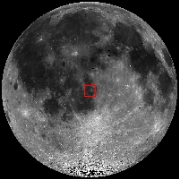 |
| Low reflectance deposits are seen along the margins of the double 'vent-like' depressions Lassell G and Lassell K (14.918°S; 351.065°E) in Mare Nubium. LROC Narrow Angle Camera (NAC) observation M1116585481R, LRO orbit 16774, February 27, 2013; Sun is overhead, north is up, field of view roughly 1.8 km across at 0.88 meters resolution [NASA/GSFC/Arizona State University]. |
James Ashley
LROC News System
Today's Featured Image follows up on the two previous posts with another look at the Lassell Massif region of Mare Nubium. These prominent low reflectance deposits line the rims of the Lassell G and Lassell K pit features (see context image below). Their occurrence along the pit rims suggest a dark layer may be present just beneath the regolith surface, whose exposure has been encouraged by mass wasting in the pit walls. What caused such steep walled pits, and what are these low reflectance materials?
Our geologic train of thought continues from yesterday's post. We were discussing the geochemical differences between iron-rich, silica-poor (basaltic) and iron-poor, silica-rich (rhyolitic) magmas in the inner Solar System. But why should this matter, and what does it have to do with our images this week? The short answer is that basaltic lavas (and basaltic impact melts) have low viscosity, where rhyolitic lavas have relatively high viscosity. Basaltic extrusions filled mare basins like lakes, cascaded over fault blocks like waterfalls, and flowed like molten rivers on the Moon. On Earth and Mars they form flood basalt deposits and low-topography shield volcanoes. By contrast, rhyolitic lavas can be visualized as having a pasty or sticky consistency. They form steeper slopes, flow more sluggishly, develop high constructs, and can erupt explosively.
Mt. St. Helens and other Cascade volcanoes are good examples for Earth.
A story of complex volcanism is emerging for the Lassell Massif region. The dark deposits may be pyroclastic in origin, and may have come from the massif source magmas themselves, or from adjacent volcanic fountaining (the floor of Lassell crater out of frame to the lower right of the context image is suspected to contain pyroclastic deposits). Based on LRO Diviner data the massif itself is silica-rich, which accounts for its topography, and suggests that Lassell G and Lassell K may be collapse calderas. They have very steep slopes and V-shaped profiles, in contrast to impact features.
Explore the full NAC frame HERE. Other examples of silica-rich, so-called 'intrusive' lunar volcanism may include the Gruithuisen Domes, features in Compton-Belkovich and the Hortensius Domes.
LROC News System
Today's Featured Image follows up on the two previous posts with another look at the Lassell Massif region of Mare Nubium. These prominent low reflectance deposits line the rims of the Lassell G and Lassell K pit features (see context image below). Their occurrence along the pit rims suggest a dark layer may be present just beneath the regolith surface, whose exposure has been encouraged by mass wasting in the pit walls. What caused such steep walled pits, and what are these low reflectance materials?
Our geologic train of thought continues from yesterday's post. We were discussing the geochemical differences between iron-rich, silica-poor (basaltic) and iron-poor, silica-rich (rhyolitic) magmas in the inner Solar System. But why should this matter, and what does it have to do with our images this week? The short answer is that basaltic lavas (and basaltic impact melts) have low viscosity, where rhyolitic lavas have relatively high viscosity. Basaltic extrusions filled mare basins like lakes, cascaded over fault blocks like waterfalls, and flowed like molten rivers on the Moon. On Earth and Mars they form flood basalt deposits and low-topography shield volcanoes. By contrast, rhyolitic lavas can be visualized as having a pasty or sticky consistency. They form steeper slopes, flow more sluggishly, develop high constructs, and can erupt explosively.
Mt. St. Helens and other Cascade volcanoes are good examples for Earth.
 |
| Another portion of NAC frame M1116585481R shows fragmented dark deposits [NASA/GSFC/Arizona State University]. |
 |
| Another look, from another angle, at the south Lassell complex, allowing some perspective of the topography - steep drops on either side of a shared wall - of the area highlighted in the Featured Image - from the newly-released LROC NAC oblique mosaic M1108311369LR, linked HERE [NASA/GSFC/Arizona State University]. |



1 comment:
rally nice picture. that picture really very rear and beauty full . thanks to shear sues picture . i also have a website .there have some pictures . you will can visit my website. thanks to all.
Information visualization Low
Post a Comment